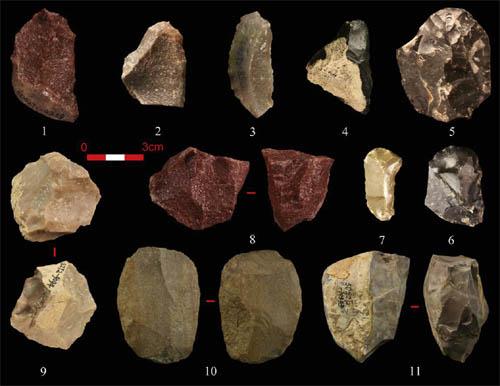Institute of Vertebrate Paleontology and Paleoanthropology
Source - http://phys.org/news/2013-03-re-examination-indicating-large-blade-technology.html

Cores and retouched tools from at Shuidonggou Locality 2. Credit: LI Feng
The blade technology is no longer accepted as a marker of modern humans, while the presence of different varieties of systematic blade production in transitional and Initial Upper Paleolithic industries remains a topic of considerable scientific interest. Dr. GAO Xing, Institute of Vertebrate Paleontology and Paleoanthropology (IVPP), Chinese Academy of Sciences, and his team re-examine the evidence for the age of the blade technology at the Shuidonggou site by comparing the lithic assemblages from the new excavations at Locality 2 with those from Locality 1, and found that the age of large blade technology appears to be around 34,000-38,000 years ago in this region, not around 24,000-29,000 years ago as thought before, suggesting a relatively rapid technology dispersal from the west and/or north. Researchers reported in the latest issue of the Journal of Human Evolution 64 (2).
The Shuidonggou Paleolithic site includes 12 localities, ranging in date from Early Late Paleolithic to Late Paleolithic, and is presently the most important site complex for the initial Late Paleolithic in northern China. It has yielded evidence of large blade production as well as the use of personal ornaments, and played an essential role in discussions of the spread of blade technology and other Upper Paleolithic traits across eastern Eurasia.
Based on the archaeological sequence and chronology at the Locality 2 in particular, researcher found that there were at least two chronologically successive technologies in the Shuidonggou region between 40,000 and 20,000 years ago. The earliest of these includes distinctive production of large blades from flat, Levallois-like cores as well as more prismatic forms. These features mark an intrusive technology spreading from north and/or west. It is succeeded by a series of 'small flake tool' assemblages characterized by generalized flake production and sidescraper-dominated toolkit.
Comparing dates and lithic technology from different layers from the Locality 1 and the Locality 2, Researchers suggested that the age of Levallois-like blade technology in the Shuidonggou area is around 34,000-38,000 years ago, based on agreement between the dates from the Locality 1 with its abundant large blade assemblage, and the dates from two cultural layers at the Locality 2.
"Results from recent excavations at Shuidonggou Locality 2 allows us to re-examine the relationship between Locality 1 and 2, using not only stratigraphy but also the technological features of the assemblages. The lithic industry of cultural layers 1 through 4 at Locality 2 is not based on large blades, so reported dates from these layers cannot be an indicator of the age of large blade technology. The findings including the most recent studies show that there is more technological diversity than previously described in the Shuidonggou sites, and the layers yielding evidence of large blade production are significantly older than the most widely accpted dates", said first author LI Feng of the IVPP.
The age of large blade technology in China is crucial to discussions of the dispersal of Upper Paleolithic technology in North Asia from west to east in Eurasia. "The data presented in this study demonstrate that the previously reported ages from the Locality 2 cannot represent the age of blade technology", said corresponding author GAO Xing, "This revised estimate is roughly contemporary with the calibrated dates from Chikhen Agui in Mongolia. We cannot reconstruct the precise pathway by which blade technology spread across East Asia due to the scarcity of well-dated Paleolithic sites. However, we agree that the large blade technology in the Shuidonggou area probably represents dispersal of cultural elements from North Mongolia and/or the Altai mountain area, where similar blade technologies provide somewhat older dates. The similarities in dates from Shuidonggou and Chikhen Agui indicate a fairly rapid spread of the large blade technology from South Mongolia to North China".
More information: www.sciencedirect.com/science/article/pii/S004724841300002X